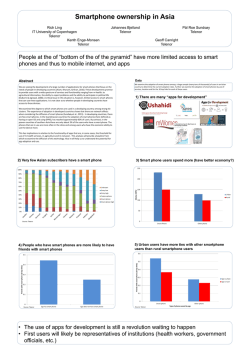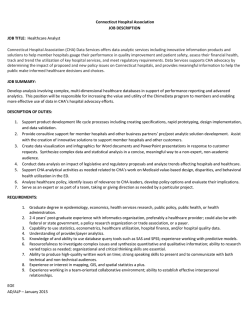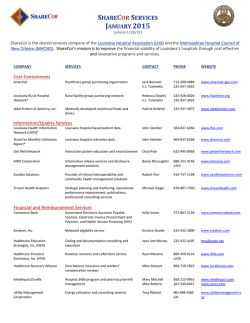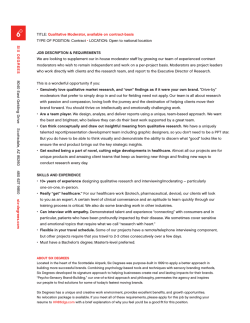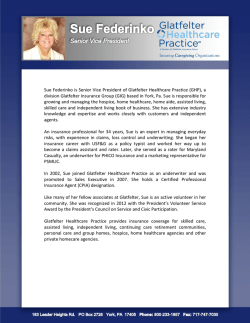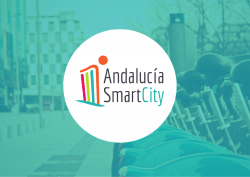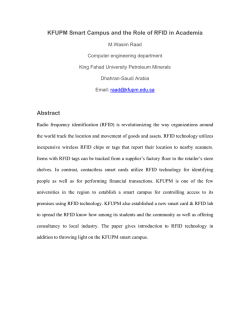
A Design of Mobile Convergence Architecture for U
International Journal of Software Engineering and Its Applications Vol. 9, No. 1 (2015), pp. 253-260 http://dx.doi.org/10.14257/ijseia.2015.9.1.22 A Design of Mobile Convergence Architecture for U-healthcare Regin Joy Conejar 1 and Haeng-Kon Kim1* 1 School of Information Technology Catholic University of Daegu, Korea [email protected], *[email protected] Abstract Ubiquitous health u-Health system is focused on the concept of providing medical service and assistance to the patients "anywhere and anytime" regardless of their locations. In u-Healthcare environment, large amounts of important medical information is processed through wireless communication. Mobile health has been receiving more and more attention recently as an emerging paradigm that brings together the evolution of advanced mobile and wireless communication technologies with the vision of “connected health” aiming to deliver the right care in the right place at the right time. This study is expected to help ensure an excellent workforce in the healthcare sector using smart phones, and to help reduce medical expenses by improving the health of citizens. Keywords: Mobile Convergence, U-healthcare, Mobile Health 1. Introduction Being a part of modern telemedicine- which generally offers higher diagnosis and treatment quality standards, reduces medical costs, and provides possibilities to handle problems of the aging human society [1]. Mobile phones have significant impact on consumers and their life style because the phones can works as small computers. Therefore, lots of applications and services have been developed and provided on mobile phones. One area of those applications is healthcare applications. In the past decade or so, mobile phones were merely seen and classified as portable communication tools, with the sole capability of making calls, without any physical connection to a landline. Today, certain advancements have been achieved in mobile computing industry through the inclusion of GPS systems, accelerometers, and even touch screens. Different kinds of mobile operating systems have been introduced in response to the goal of designing increasingly powerful software to take advantage of the number of processors packaged in computing hardware. Some of these operating systems are the Symbian OS, the Apple Ios Windows Mobile and Android. Due to the advanced nature of computer architectures for embedded systems computing, mobile computing has become well integrated into the very fabric of our modern way of living. It is a very useful tool for personal health monitoring and many devices such as iPhone, iPad, Google Nexus and other mobile computing devices have applications developed for health monitoring and targets specific needs of individuals. Our developed application which runs on the android platform is customizable and user friendly. * Corresponding Author ISSN: 1738-9984 IJSEIA Copyright ⓒ 2015 SERSC International Journal of Software Engineering and Its Applications Vol. 9, No. 1 (2015) 2. Related Works 2.1. Evolution of mobile Devices The convergence of technologies provides many advantages to consumers. Due to the combination between advanced mobile phone technology and computer technology at present, mobile phones are not just telephones, they have become smart phones. Particularly, after the 3rd Generation International Mobile Telecommunications or 3G mobile networks were officially launched in Thailand in May 2013, smart phones and other mobile devices can be used efficiently because the transmission speed of data increases significantly. 2.2. Mobile Health Mobile Health can combine health and mobile device technology, especially smart phones. It can be defined as “medical and public health practice supported by mobile devices (e.g., mobile phones, patient monitoring device and wireless devices)”, whereas, 10 years ago, it has been defined as wireless telemedicine involving the use of mobile telecommunications and multimedia technologies and their integration with mobile healthcare delivery systems [2]. Figure 1. The Ecosystem for Mobile Health 2.3. Innovation in Healthcare Innovation in healthcare continues to be a driving force in the quest to balance cost containment and health care quality. Healthcare innovation can be defined as the introduction of a new concept, idea, service, process, or product aimed at improving treatment, diagnosis, education, outreach, prevention and research, and with the long term goals of improving quality, safety, outcomes, efficiency and costs [4]. 254 Copyright ⓒ 2015 SERSC International Journal of Software Engineering and Its Applications Vol. 9, No. 1 (2015) The conceptual framework for innovation in healthcare is as shown in Figure 2. The healthcare organizations serve six distinct purposes – treatment, diagnosis, prevention, education, research and outreach. In serving these purposes, healthcare organizations must manage quality, costs, safety, efficiency and outcomes. At the very core of healthcare innovation are the needs of patients and the healthcare providers who deliver care. Healthcare innovation focuses mainly on three areas– a) how the patient is seen, b) how the patient is heard, and c) how the patient’s needs are met. Figure 2. A Conceptual Framework for Innovation in Healthcare 2.3. Digital Convergence Digital convergence is a certainty of future. Among hoards of other benefits that it offers one of the striking features of this technology is lower storage cost of digital data. Also, it offers enhanced quality of digital content and an assurance of quality improvements in future along with low cost and high bandwidth transmission of digital content between any two places. In the age of digital convergence, integrated media will be useful to engage consumers with sufficient opportunities to strengthen their know-how of healthcare and create awareness about risk, cost and benefits of specific procedures. 2.4. Healthcare Engineering The use of systems-engineering tools leads to innovation in health care. These engineering-information technology based tools have been used in a wide variety of applications to achieve major improvements in the quality, efficiency, safety or customercenteredness of processes, products, and services in various manufacturing and services’ industries. However, the healthcare sector as a whole has been very slow to embrace them, even though they have been shown to yield valuable returns to the growing number of health care organizations (Fone et al.,). Copyright ⓒ 2015 SERSC 255 International Journal of Software Engineering and Its Applications Vol. 9, No. 1 (2015) 2.5. Smart Technology Smart technology does not mean that the technology itself is smart, but can be said that individuals and industry has become smarter. Smart technology providing individualized products and service to quickly correspond, sensitively analyze, predict occurring situations have the five features of sensing, intelligence, mobility, elasticity, and integration. 2.6. Smart healthcare Using smart healthcare, simple medical service can be possible without visiting the hospital in the future. Through bio sensors attached to our bodies, our heart rate and ECG is monitored by real-time throughout our everyday life. Through this monitoring process, strange symptoms in our body will immediately be detected to send necessary messages. 2.7. A Smart Device Any instrument, apparatus, appliance, material or other article (whether used alone or in combination, and including the software necessary for its proper application) intended, by the person under whose name it is or is to be supplied, to be used for human beings for the purpose of one or more of the following: 1. diagnosis, prevention, monitoring, treatment or alleviation of disease; 2. diagnosis, monitoring, treatment, alleviation of or compensation for an injury or disability; 3. investigation, replacement or modification of the anatomy or of a physiological process; 4. control of conception; 5. and that does not achieve its principal intended action in or on the human body by pharmacological, immunological or metabolic means, but that may be assisted in its function by such means. 2.8. Digital Convergence Digital convergence is a certainty of future. Among hoards of other benefits that it offers one of the striking features of this technology is lower storage cost of digital data. Also, it offers enhanced quality of digital content and an assurance of quality improvements in future along with low cost and high bandwidth transmission of digital content between any two places. In the age of digital convergence, integrated media will be useful to engage consumers with sufficient opportunities to strengthen their know-how of healthcare and create awareness about risk, cost and benefits of specific procedures. 3. Conceptual Model for Smart IT Convergence for U-Healthcare One of the key benefits of smart medical tools is fostering a sense of patient efficacy. For medical professionals, more data is useful when helping a patient make informed health care decisions. Using smart phone medical application that checks other symptoms provides physicians with a wealth of clinically useful information. This is why medical monitoring application is one of the most important technological tools to promote ‘selfcare’ and prevention of disease. 256 Copyright ⓒ 2015 SERSC International Journal of Software Engineering and Its Applications Vol. 9, No. 1 (2015) Figure 3. Mobile Convergence for U-Healthcare Smart mobile can perform actions such as communicating with other devices, storing information, and retrieving online documents shown in Figure 3. If we consider a typical mobile user for example, an agent might operate on their smart phone or PDA, monitor the user’s behavior in an autonomous fashion, react to any perceived changes in the user’s status, and proactively anticipate what the user’s future behavior will be. 3.1. Mobile U-Healthcare Application Model Smart devices and their services play a significant and mounting part in a global world of computing. Software infrastructure that construct and establish application functionality, unified passage of reasoning among mobile devices and other environment, mobile devices software modeling, and scalability of the results should be transpire in order to create a quality of software infrastructure for mobile device. There is no standard model or rule to design and develop mobile u-healthcare applications. In order to support the medical specialists such as doctor, physician and therapist for developing personalized mobile u-healthcare applications, an application model for the mobile u-healthcare applications should be defined prior to the implementation of the workbench. Figure 4. Application Model Copyright ⓒ 2015 SERSC 257 International Journal of Software Engineering and Its Applications Vol. 9, No. 1 (2015) Ministered by the explosion of smart phones and wireless technology, the u-health revolution has helped people become more personally accountable for their lifestyle choices. Mobile applications (apps), engage people in a way that enables them take better care of themselves and manage ailments. The electronic or digital data gathered in real time is useful to motivate, inspire, track progress and reward effort, which is crucial to success. These gadgets and new app technologies have become more slim and lightweight to accommodate the longest run or walk around the park. 4. Software Framework It is designed and implemented as software framework to be able to provide a set of generic functionalities that can be selectively utilized by application developers, thus providing application specific software focusing on monitoring of different health problems. As part of the framework, it offers a software library providing application programming interfaces (APIs). Figure 5. Software Framework for Smart U-healthcare Data Service manages record between platform and devices get the records used for retrieving patient records from personal devices, which could be health information systems or medical application servers. Medical services provide diagnosis and medication for all the symptoms given by the user generated from the health information system and medical application platform. Health information system provides information pertaining to the symptoms or disease given by the user. Personal self-monitoring and remote physicians provided proper medical assistance to the user. 4.1. Convergence System Components for U-healthcare Service Using smart healthcare, simple medical service can be possible without visiting the hospital in the future. Through this monitoring process, strange symptoms in our body will immediately be detected to send necessary messages. This will prevent losing opportunity of therapy time. Also, real-time monitored data will be analyzed based on medical information for simple diseases to be cured without going to the hospital. 258 Copyright ⓒ 2015 SERSC International Journal of Software Engineering and Its Applications Vol. 9, No. 1 (2015) Figure 6. Convergence System Components Medical data of patients will continuously be accumulated and managed. Based on this collected data, the condition of patients will comprehensively analyze with medical records from the past until today. Figure 7. Development of the Patient-Specific Healthcare Platform 5. Conclusion Advancements in ubiquitous technology ushers us into a new world. This study is expected to help ensure an excellent workforce and new technologies in the healthcare sector using smart phones, and to help reduce medical expenses by improving the health of citizens. Smart mobile have been rapidly penetrating into the everyday life with various applications. With the advancement of communication and computing technologies, the smart devices are evolving toward the convergence with other industry sector. Healthcare is one such beneficiaries by the IT convergence. In the future, U-Healthcare will be further integrated into our daily lives such that we will not perceive its presence consciously, and it will allow us to monitor our health status naturally and continuously. However, even the most highly developed technology can be neglected by consumers if it is not user-friendly. Therefore, u-healthcare needs to fully reflect the required services to obtain maximal participation and behavioral change. UHealthcare market will be reorganized as healthcare device and platform in the near future. Copyright ⓒ 2015 SERSC 259 International Journal of Software Engineering and Its Applications Vol. 9, No. 1 (2015) References [1] [2] Itepanian, R. et al.: M-Health: Emerging Mobile Health Systems. Springer (2005). Gartner Identifies the Top 10 Consumer Mobile Applications for 2012. Available at: http://www.gartner.com/newsroom/id/1230413, accessed August 2013. [3] Arshad U., et al.: Exploiting Mobile Computing in Health Care. Department of Computer Science, University College London. Webpage: www.cl.cam.ac.uk/~cm542/papers/iwsawc.pdf [date accessed: Dec 12, 2012] [4] 4. B.-M. Choi, “A Study on Setting up the Concept of Smart City through Analysis on the Term ‘Smart”, JKCA, Korea Contents Association, vol. 11, no. 12, (2011). [5] Fone, D., Hollinghurst, S., Temple, M., Round, A., Lester, N., Weightman, A., Roberts, R., Coyle, E., Bevan, G. and Palmer, S. (2003). Systematic review of the use and value of computer simulation modelling in population health and health care delivery. Journal of Public Health Medicine, 25(4), 325– 335. [6] S.-H. Lee and D.-W. Lee, “A Study on Review and Consideration of Medical Industry Convergence Based on U-healthcare”, The Journal of Digital Policy & Management, The Society of Digital Policy & Management, vol. 11, no. 6, (2013), pp. 182-186. [7] Hapi HL7 SDK (http://hl7api.sourceforge.net/). [8] Unlocking the Power of Health Information, (http://www.hl7.org/). [9] UBN, The Solution Enables, http://www.ubnsoft.com/ubnblog/?p=739. [10] http://www.tga.gov.au/industry/devices-software-mobile-apps.htm#.UuXTsdKmrIV 260 Copyright ⓒ 2015 SERSC
© Copyright 2026
